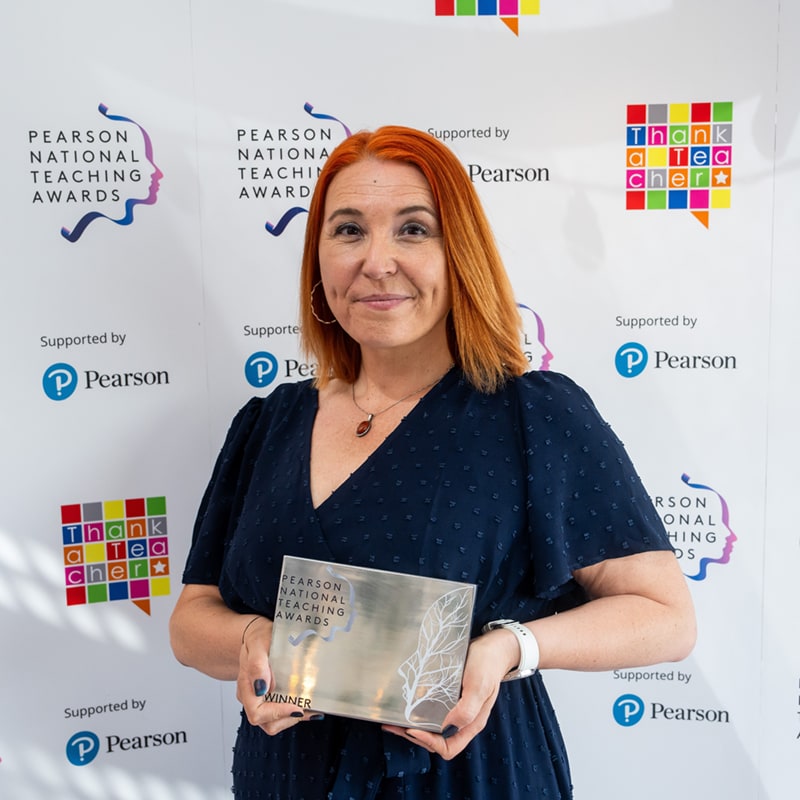Bridging the digital divide – two teachers share their stories
Two teachers share their stories of how they’re tackling the digital divide in their schools.
Technology has the potential to revolutionise teaching, learning and assessment, and its impact is clear. The 2023 Pearson School Report, which showcased the views of more than 6000 educators across England, revealed that:
34% of teachers have seen improvements in accessibility for learners with SEND via technology
34% of teachers say students' engagement has improved due to the use of technology
62% of teachers expect to see greater emphasis on digital and tech-enabled learning in the next 10 years.
With that in mind, we recently brought together 60 educators, students and leaders across the sector for our Digital in School Roundtable to help the education community collectively pioneer change within the ever-evolving digital landscape. Alongside discussing the positives and possibilities that we can unlock with technology, there were also the problems we need to solve.
Time and again, the digital divide came up as a key challenge and as the use of technology in schools expands, so too do concerns over digital inequalities. Recent research from Digital Poverty Alliance indicates that 20% of children live in digital poverty, meaning they cannot “interact with the online world fully, when, where and how an individual needs to”.
So, we asked two educators to share what they’re innovating in their schools to tackle the digital divide – from device access to minimising disadvantage gaps for good.
The cost of reliable digital infrastructure that enables digital solutions in schools is a barrier that stretches school budgets beyond most people's definition of what would allow for strategic investment in technology. The divide between those who have reliable access to digital technology and those who don’t does not stop at the school gates either – access at home is also a fundamental challenge.
Whilst this is not something that can be fixed overnight, at Fulford we have implemented a few initiatives to help lessen the divide. Literacy and numeracy are rightly considered to be the most important skills that students learn in school, but I don't think it's too controversial to argue that digital literacy is becoming equally significant to a student's future life chances.
With this in mind, in 2022, we developed and introduced Digital Life Skills as an informal qualification where every student can pick up the digital skills that our students said were essential to thrive at home, school and work. This was great at helping students prepare for the world of work, especially if their access to technology at home was limited, however, we still noticed a significant gap in the confidence and ability of students lower down the school from disadvantaged backgrounds.
So, last year, we also introduced new Digital Literacy support in Year 7 for targeted groups of students who would benefit most from the additional support accessing the online tools necessary to get support from teachers and access or complete homework, in addition to timetabled computing lessons.
Another initiative at the school to help combat the digital divide is our award-winning STEM club, which prioritises access to underrepresented or disadvantaged groups and regularly works with examples of diverse career role models into computing lessons and homework activities so that every student feels like they can enjoy success regardless of their starting point.
We've got a long way still to go, but we're working on creating routines and resources so that students who don't have the same level of access to digital support at home can still thrive without feeling singled out, such as computing homework that can be completed on a smartphone rather than requiring a tablet, desktop or laptop with specific software.
Whilst we are proud of what we have implemented and achieved with these programmes, there’s always more that can be done.
What next?
If we want equitable access for all students to enjoy the benefits of digital learning, we need to invest in computing education at KS1-3 for all as a much higher priority. This means expanding the timetable allocation for computing in schools, investing in staff training and development, celebrating and sharing success and supporting schools that struggle to recruit or retain qualified teachers with additional time and funding.
The digital divide is something that I feel is very apparent in schools when it comes to not just their education but also their general lives. You can tell the children who have access to technology and the children who don't. It affects their levels of confidence, their aspirations, and their opinions about what they're capable of achieving in the future.
Students’ ambitions at my school were really quite low when I joined 10 years ago, and I wanted to find a way to make a change there through the use of technology. The school has quite a high proportion of disadvantaged children, so over the years we’ve worked to introduce lots of initiatives to try and support students to be able to access a variety of experiences with tech that will raise their cultural capital. We have worked closely with an amazing local charity called EveryChildOnline who enable UK organisations to donate decommissioned IT equipment which they then refurbish and pass on to schools. This has allowed us to provide technology to students who do not have access at home and also has enhanced our lessons with specialist technology that we would not have otherwise been able to offer.
For example, we have an e-sports club, which is connected to the games development courses that we run. We run ‘game jams’, which are events usually lasting 1 or 2 days where participants compete to make a game in line with a theme which is revealed when the game jam begins. It is a popular event amongst professional game developers and gives participants a great opportunity to immerse themselves in an industry-style fun activity. Students have access to VR technology and gaming consoles, and there are also coding clubs available, where we then encourage the students to enter national competitions such as the BEBRAS Challenge. A huge priority of mine with all of the initiatives is to encourage girls to participate to dispel any myths around gender biases.
We’ve seen amazing results through these initiatives, such as post-16 students going on to study games development at university and creating their own games, as well as a huge uptick of female students continuing their computing education into Key Stages 4 and 5, but there is so much more that can be done to make technology more accessible for all students.
Schools are finding innovative ways to provide the technology to bridge the digital divide, and access to technology in itself is a hugely important thing, but I think it runs deeper than that. Young people – and teachers – often don't know how to use technology effectively, even when they do have access to it. Addressing this is the key next step.
What next?
It needs to start with teacher training. There's a common assumption that adults naturally possess computer skills, but this isn't always true. In reality, 24% of teachers consider a lack of confidence in their digital skills as a barrier to using technology in learning. Particularly in primary schools, where educators are tasked with teaching computing despite their own uncertainties, this situation creates a ripple effect that impacts students directly.
Training should be provided to all teachers – not just those in computing – so that technology is embedded in lessons across the curriculum and should cover not only how to use technology effectively, but also lessons on what children need to know to use technology effectively as adults.
Combining this with the provision of technology experiences is so key for learners because everything that we do in our lives revolves around technology these days in some way or another. We must get this right.

